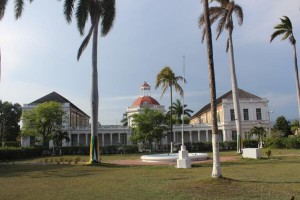Pre Columbus – Inhabited by the Tainos from 1000 b.c.e. to 1494. Tainos came to the Island from South America. They were a peaceful group of people who named it Xamayca which means land of wood and water.
1494 May 4 – Christopher Colombus arrived in Jamaica and landed at Discovery Bay on his second voyage to the New World and named the Island Santiago. However the name Santiago was never adopted and Xamayca later Jamaica was the name that was used by the Spanish in reference to the Island.
1509 – First Spanish settlement called Sevilla Nueva (New Seville) was established on the Coast of St Ann by Juan de Esquivel from Santo Domingo.
1534 – The Spanish relocated to a new settlement and named it Villa de la Vega and later Santiago de La Vega. By the end of the 16th century the entire population of the Tainos died out due to enslavement by the Spaniards and exposure to European diseases such as small pox and measles. Africans were brought as slaves to work on the sugar plantations.
1655 May 10 – English soldiers and pirates lead by Admiral Penn and General Venables arrived at Passage Fort in Kingston Harbour. The English marched to Santiago de la Vega and on May 11, 1655 where The Spaniards surrendered. Santiago de la Vega was destroyed by the British but remained the official capital of Jamaica. The English called the old Spanish Capital St Jago de la Vega and later renamed it Spanish Town.
The city of Port Royal becomes a major pirate’s haven in the Americas British established Port Royal as the major centre of trade and the city also functioned as the unofficial capital of Jamaica. Port Royal became known as the richest city in the New World.
1670 – Jamaica was officially ceded by Spain to England under the treaty of Madrid.
1692 June 7 – Port Royal was destroyed by an Earthquake where most of the city was submerged under the sea.
1692 July 22 Kingston was founded as the population of Port Royal is relocated. Kingston quickly becomes the largest commercial centre in Jamaica. Spanish Town was rebuilt and fully functioned as the capital of Jamaica. Jamaica becomes the largest producer of sugar for Great Britain
1755 – In recognition of 100 years of English rule, the governor signed a decree declaring Kingston as the New Capital of Jamaica.
1758 – Spanish Town restored its function as the capital of Jamaica as the decree by the governor in 1755 to make Kingston the capital of Jamaica was never sanctioned by the King and was therefore ruled as illegal.
1838 August 1 – Slavery was abolished by the English. Former African slaves encouraged to become indentured workers on the plantations.
1860 – Influx of migrants from China and India came to work on the plantations
1872 – Kingston was established as the capital of Jamaica.
1944 – Universal Adult Suffrage guarantees all adults 18 and over the right to vote
1962 August 6 – Jamaica was granted independence by Great Britain but remained a member of the British Commonwealth.
1968 – The birth of Reggae music
1981 May 11 – Bob Marley died
2008 August – Jamaican athletes dominated the track and field sprint events at Beijing Olympics



